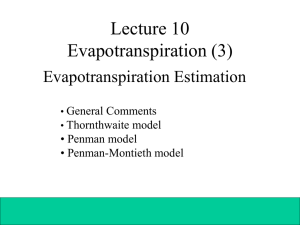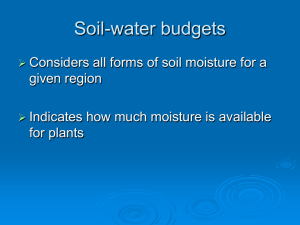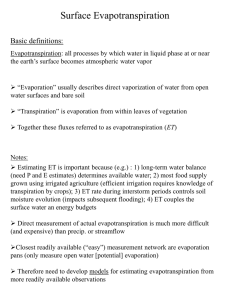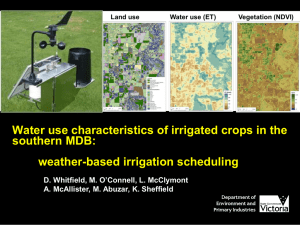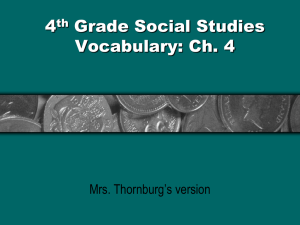A computer system of estimating reference crop evapotranspiration
advertisement
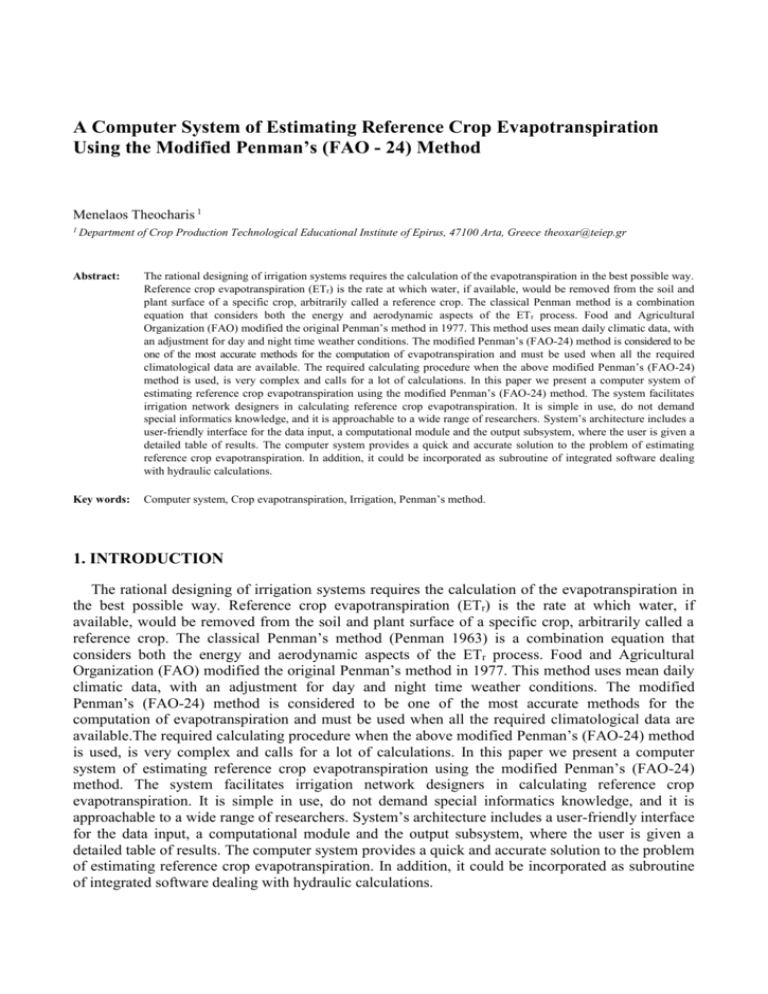
A Computer System of Estimating Reference Crop Evapotranspiration Using the Modified Penman’s (FAO - 24) Method Menelaos Theocharis 1 1 Department of Crop Production Technological Educational Institute of Epirus, 47100 Arta, Greece theoxar@teiep.gr Abstract: The rational designing of irrigation systems requires the calculation of the evapotranspiration in the best possible way. Reference crop evapotranspiration (ETr) is the rate at which water, if available, would be removed from the soil and plant surface of a specific crop, arbitrarily called a reference crop. The classical Penman method is a combination equation that considers both the energy and aerodynamic aspects of the ETr process. Food and Agricultural Organization (FAO) modified the original Penman’s method in 1977. This method uses mean daily climatic data, with an adjustment for day and night time weather conditions. The modified Penman’s (FAO-24) method is considered to be one of the most accurate methods for the computation of evapotranspiration and must be used when all the required climatological data are available. The required calculating procedure when the above modified Penman’s (FAO-24) method is used, is very complex and calls for a lot of calculations. In this paper we present a computer system of estimating reference crop evapotranspiration using the modified Penman’s (FAO-24) method. The system facilitates irrigation network designers in calculating reference crop evapotranspiration. It is simple in use, do not demand special informatics knowledge, and it is approachable to a wide range of researchers. System’s architecture includes a user-friendly interface for the data input, a computational module and the output subsystem, where the user is given a detailed table of results. The computer system provides a quick and accurate solution to the problem of estimating reference crop evapotranspiration. In addition, it could be incorporated as subroutine of integrated software dealing with hydraulic calculations. Key words: Computer system, Crop evapotranspiration, Irrigation, Penman’s method. 1. INTRODUCTION The rational designing of irrigation systems requires the calculation of the evapotranspiration in the best possible way. Reference crop evapotranspiration (ETr) is the rate at which water, if available, would be removed from the soil and plant surface of a specific crop, arbitrarily called a reference crop. The classical Penman’s method (Penman 1963) is a combination equation that considers both the energy and aerodynamic aspects of the ETr process. Food and Agricultural Organization (FAO) modified the original Penman’s method in 1977. This method uses mean daily climatic data, with an adjustment for day and night time weather conditions. The modified Penman’s (FAO-24) method is considered to be one of the most accurate methods for the computation of evapotranspiration and must be used when all the required climatological data are available.The required calculating procedure when the above modified Penman’s (FAO-24) method is used, is very complex and calls for a lot of calculations. In this paper we present a computer system of estimating reference crop evapotranspiration using the modified Penman’s (FAO-24) method. The system facilitates irrigation network designers in calculating reference crop evapotranspiration. It is simple in use, do not demand special informatics knowledge, and it is approachable to a wide range of researchers. System’s architecture includes a user-friendly interface for the data input, a computational module and the output subsystem, where the user is given a detailed table of results. The computer system provides a quick and accurate solution to the problem of estimating reference crop evapotranspiration. In addition, it could be incorporated as subroutine of integrated software dealing with hydraulic calculations. 2. THE MODIFIED PENMAN’S (FAO-24) METHOD Food and Agricultural Organization (FAO) modified the original Penman equation (Penman 1963) in 1977. The modifications included a revised wind function, an adjustment factor to account for local conditions and the assumption that the daily average ground heat flux is zero. This method uses mean daily climatic data, with an adjustment for day and night time weather conditions. The modified equation used in this method (Doorenbos and Pruitt 1977; Jennifer, 2001) is: ETr C ρw (R n G) (1 W)f(u)(e a e d ) W λ (1) where ETr is the reference evapotranspiration, mm/day; W is a temperature and the altitude of the area related weighting factor; Rn is the net solar radiation, MJm-2d-1; G is the soil heat flux in MJm-2d-1; λ is the latent heat of evaporation, MJ kg-1; ρw = 1000 kgm-3, is the density of water; f(u) is the wind related function, kg hPa-1m-2d-1; ea is the saturation vapour pressure at mean air temperature, hPa; ed is the mean actual vapour pressure of the air, hPa; and C is an adjustment factor to account for day and night weather conditions. 2.1 Weighting Factor (W) This is a weighting factor for the effect of solar radiation, the wind and humidity on ETr. It is given by the equation: W Δ Δγ (2) -1 where Δ is the rate of change of saturation vapour pressure with temperature, hPa 0C , and γ is -1 the psychometric constant, hPa 0C , which are calculated from the equations provided by Brunt (Brunt 1952), and Bosen (Bosen 1960) respectively: 4098 Ta 237.3 2 17.27 T -1 a 6.11 exp hPa 0C T 237.3 a (3) and 5.2586 0.0065 1 h 273 Ta γ 1.5156 0.0014307 Ts hPa 0C -1 (4) where Ta and Ts are the daily mean air and water temperature, 0C; and h is the altitude of the area, m. 2.2 Humidity (ea-ed) Humidity is expressed as the difference between the mean saturation water vapour pressure (ea) and the mean actual vapour pressure (ed). From Tetens (Tetens 1930), saturated air vapour pressure as a function of temperature, ea, can be computed as follows: 17.27 T a e a 6.11 exp hPa T 237.3 a (5) The actual vapour pressure is calculated using saturation vapour pressure and the mean relative humidity: e d e a Rh mean hPa (6) Therefore: 17.27 T a e a e d (1 - Rh mean )6.11 exp T 237.3 a hPa (7) 2.3 Wind Factor ( f(u) ) Wind Factor expressing the effect of wind on ETr using the modified Penman’s (FAO-24) method, is calculated (Doorenbos and Pruit 1997) from: f (u) 0.27(1 0.86u 2 ) kg hPa-1m-2d-1 (8) Wind speed is measured at many different heights above the ground surface. The Penman’s equation requires wind speed at a height of 2.00 m. It can be adjusted to a height of 2.00 m by: 2 u2 uz z 0, 2 ms-1 (9) where: u2 and uz is the wind speed corresponded at height of 2.00 m and z m, in ms-1; and z is the height of wind measurement, m. 2.4 Net Radiation (Rn) Net Radiation is the difference between incoming and outgoing solar radiation. It can be measured, but such data are seldom available. Instead, it is calculated from solar radiation on sunshine hours, temperature, and humidity data (Koutsoyiannis and Xanthopoulos 1997; Papazafiriou 1999). The FAO-24 Penman’s approach calculates Rn as follows: The net radiation is the algebraic sum of the net shortwave radiation (Rns) and net longwave radiation (Rnl). As Rnl constitutes a loss, this relationship is: R n R ns R nl MJm-2d-1 (10) Net shortwave radiation (Rns), can be calculated by correcting the incoming solar radiation for surface albedo (α) of the crop surface by: R ns 1- α R s MJm-2d-1 (11) where: α = 0.05 for water surface; α = 0.15 for bare soil surfaces; and α = 0.23 for green vegetated surfaces. For most crops = 0.25. Solar radiation (Rs), is calculated using the amount of radiation received at the top of the atmosphere (Ra). This value is calculated (Duffie and Beckman 1980,1991) by: R a 3.6 2 I s d r 180 ω s sin φ sin δ sin ω s cosφ cosδ 15 π MJm-2d-1 (12) -2 where: I s 1.367 kWm is the solar constant; dr is the relative distance from the sun to the earth; φ is the station latitude, degrees; δ is the declination of the sun, degrees; ωs is the sunset hour angle, degrees; The values of dr , δ and ωs are calculated respectively from: 360 d r 1 0.034 cos J 2.86479 365 0 (13) 360 δ 23.45 sin ( 284 J ) 365 and 0 0 (14) ωs arccos ( tan φ tanδ) degrees (15) In the above relations, J is the Julian day of the year considered given from: J 30,5M 14,6 (integer) (16) where M =1,2,3,…,12 is the number of the month considered. After that solar radiation (Rs), is obtained with the Angstrom formulation: n R s 0.25 0.50 R a MJm-2d-1 N (17) where n and N are correspondently the actual and the maximum possible sunshine hours , hd-1; and Ν 2 ωs 15 hd-1 (18) Net longwave radiation (Rnl), can be determined from available temperature, the vapour pressure and the n/N ratio data by the equation: R nl ε n f L σ(Ta 273) 4 MJm-2d-1 (19) where σ = 4.903*10-9 , MJ K-4 m-2 day-1, is the Stefan-Boltzmann constant ; εn is the net emissivity factor which is calculated by e n 0.34 - 0.044 e d ; and fL is the cloudiness adjustment factor which is calculated by f L 0.1 0.9 n . N Therefore Rnl can be determined by: n R nl σ(Ta 273) 4 0.34 - 0.044 e d 0.1 0.9 N MJm-2d-1 (20) 2.5 Soil Heat Flux (G) Soil heat flux is calculated from the relation provided by Jensen et al. (1990): G cs d s Tn 1 Tn 1 Δt or G 2 c s d s Tn Tn 1 Δt MJ m-2d-1 (21) where Tn+1, Tn and Tn-1 are respectively the mean temperature on next month n+1, month considered -1 n, and on previous month n-1, 0C; cs is the soil heat capacity = 2.1MJ m-3 0C ; Δt is the length period ; ds is the estimated effective soil depth and ds = 0,18 m for daily temperature fluctuations and ds = 0,03 m for monthly temperature fluctuations (Jensen et. al. 1990). Therefore G can be determined by: G 0,38 Td Td1 MJ m-2d-1 for daily temperature fluctuations and by: G 0,14 Tn Tn 1 or G 0,07 Tn 1 Tn 1 MJ m-2d-1 for monthly temperature fluctuations. Note: The soil heat flux is generally very small and it is assumed to be G = 0.01Rn during the day and G = 0.02Rn during the night. According to FAO-24 modifications it is assumed that the daily average ground heat flux is zero. 2.6 Adjustment Factor (C) The Penman equation assumes that the most common conditions occur when radiation is medium to high, maximum relative humidity is medium to high and moderate daytime wind about double the night time wind. These conditions are not always met. The Penman equation has to be corrected in such situations using an adjustment factor. The adjustment factor as developed by Allen et al. (1989) and obtained from Jensen et al. (1990) is given by: C 0.892 - 0.0781u d 0.00219 u d R s 0.000402 Rh max R s 0.000196 ud u d Rh max un 0.0000198 ud un u d Rh max R s 0.00000236 u 2d Rh max u 0.0000000292 d un u R s 0.0000086 d un 2 u Rh d max (22) 2 u 2 Rh 2 R 0.0000161 Rh max s max R s d where ud and un are correspondently the daytime and night time wind speed, ms-1; λ 2.501 0.002361Ts MJ kg-1 ; (23) and R s Rs ρwλ mmd-1 (24) Note: The modified Penman’s (FAO 24) method requires day and night wind speed. If the wind data to evaluate the correction factor are not available, it is adequate to estimate that the ud/un value is 1.5 during the convective season and 1.85 during the frontal season. 2.7 Reference Crop Evapotranspiration (ETr) After combining the above equations, the modified Penman’s (FAO-24) equation is given by: ETr C ρw Rn W λ (1 W)f(u)(e a e d ) (25) where all the parameters used, are as above have been described. 3. ESTIMATING REFERENCE CROP EVAPOTRANSPIRATION ACCORDING TO THE MODIFIED PENMAN’S METHOD (FAO-24) USING PERSONAL COMPUTER The required calculating procedure when the above modified Penman’s (FAO-24) method is used, is very complex and calls for a lot of calculations. For this reason, we found necessary to develop a simple computer system that enables researchers and students to easily calculate reference crop evapotranspiration. This program, being accessible by those who need it, could be embedded as subroutine in larger computer systems dealing with hydraulic calculations. 3.1 Organising the Input Parameters The first step is to organise the data for the problem on the spreadsheet. In Figure 1, the input parameters for the altitude of the area, h in m, the height of wind speed measurement, z in m , the wind speed corresponded at height z, u z in m/s, the number of the month considered, M, the station latitude, φ in degrees, the daily mean air temperature, Ta in 0C, the daily mean water temperature, Ts in 0C, the actual possible sunshine hours, n in h/d, the ratio of daytime and nighttime wind speed ud/un, the mean relative humidity, Rhmean in %, and the maximum relative humidity, Rhmax in %, were entered in cells e15, i15, m15, e18, i18, m18, e21, i21, m21, e24 and i24 respectively. Figure 1. Spreadsheet of data and calculations of ETr using the modified Penman’s (FAO-24) method. 3.2 Solving the Problem In order to solve the problem the following macro command is created: Sub Crop_Evapotranspiration () ‘Macro recorded in 24/1/2009 by M. Theocharis Range("f3") = "Estimating Reference Crop Evapotranspiration " Range("f4") = "Using the Modified Penman's Method (FAO 24)" Range("h12") = "Input Parameters " h = Range("e15").Value z = Range("i15").Value uz = Range("m15").Value M = Range("e18").Value φ = Range("i18").Value Ta = Range("m18").Value Ts = Range("e21").Value n = Range("i21").Value Ru = Range("m21").Value Rhmean = Range("e24").Value Rhmax = Range("i24").Value Δ = (4098/((Ta+237.3)^2)*6.11*exp(17.27*Ta/(Ta+237.3))) γ = ((1-0.0065*h/(273+Ta))^5.2586)/(1.5156-0.0014307*Ts) W = Δ/(Δ+γ) Range("e30") = W ea = 6.11*Exp(17.27*Ta/(Ta+237.3)) ed = ea*Rhmean/100 Range("i30") = ea-ed Fu = (0.27*(1+0.86*uz*(2/z)^0.2)) Range("m30") = Fu J = Int(30.5*M-14.6) dr =1+0.034*Cos((4*Atn(1)/180)*(360*Int(30.5*M-14.6)/365-2.86479)) δ = 23.45*Sin((4*Atn(1)/180)*(360*(284+Int(30.5*M-14.6))/365)) cosωs = -Tan(4*Atn(1)*φ/180)*Tan(4*Atn(1)*δ/180) ωs = (180/(4*Atn(1)))*(Atn(-cosωs/Sqr(-cosωs*cosωs+1))+2*Atn(1)) Ra = 1/15*(3.6*2*1.367*dr)*(ωs*Sin(4*Atn(1)*φ/180)*Sin(4*Atn(1)*δ/180)+(180/(4*Atn(1)))* Sin(4*Atn(1)*ωs/180)*Cos(4*Atn(1)*φ/180)*Cos(4*Atn(1)*δ/180)) Ν = (2/15)*ωs Rs = (0.25+0.5*n/Ν)*Ra Rns = (1-0.25)*Rs Range("e33") = Rns Rnl = 4.903*10^-9*((Ta+273)^4)*(0.34-0.0442719*ed^0.5)*(0.1+0.9*n/Ν) Range("i33") = Rnl Rn = Rns-Rnl Range("m33") = Rn λ = 2.501-0.002361*Ts Range("e36") = λ C = 0.892-0.0781*(uz* (2/z)^0.2)+0.00219*(uz*(2/z)^0.2)* Rs/λ+0.000402* Rhmax* Rs/λ+ 0.000196* Ru*(uz* (2/z)^0.2)* Rhmax+0.0000198* Ru*(uz* (2/z)^0.2)* Rhmax *Rs/λ+ 0.00000236* (uz*(2/z)^ 0.2)^2*Rhmax*Rs/λ-0.0000086*Ru^2*(uz*(2/z)^0.2)*Rhmax0.0000000292* Ru*(uz*(2/z)^0.2)^2* Rhmax^2*Rs/λ-0.0000161*Rhmax*(Rs/λ)^2 Range("i36") = C ETr = C*(W*Rn /λ+(1-W)*(0.27*(1+0.86*uz*(2/z)^0.2))*(ea-ed)) Range("m38") = Round(ETr,3)&" mm/d" End Sub After that we click the “Solutions” button and the solution of the problem results.The described procedure is shown in Figure 1. 4. APPLICATION Below the reference crop evapotranspiration in Arta, Greece area for the month July are estimated, using the above described computer system, Figure 1. For the input parameters: h = 150.00 m; z =10.00 m ; u z = 3.30 m/s; M=7 ; φ = 39.13 0 ; Ta = 25.30 0C ; Ts =15.00 0C ; n =11.26 hd-1; ud/un = 1.50 ; Rhmean = 64.90 % ; and Rhmax = 79.90 % ; it emerges that: W = 0.7445 ; ea-ed = 11.323 hPa ; f(u) = 0,825 kg hPa-1m-2d-1 ; Rns= 19.489 MJm-2d-1; Rnl = 4.275 MJm-2d-1 ; Rn =15.214 MJm-2d-1; λ= 2.466 MJ kg-1; C = 1.063 and finally the reference crop evapotranspiration ETr =7.421 mm/d. 5. CONCLUSIONS Solving problems of estimating reference crop evapotranspiration is of prime importance for the study of irrigation networks. The required calculating procedure when the modified Penman’s (FAO-24) method is used is very complex and calls for a lot and very laborious calculations. This is why FAO developed various tables where the values of the calculating parameters are provided. But these tables are very unpractical in use and include significant inaccuracies in values determination. Besides, it is impossible to use them when trying to solve the problems using a computer. The computer system presented in this paper is simple in use, does not demand special informatics knowledge and is approachable to a wide range of researchers. In addition, it could be incorporated as subroutine of integrated software dealing with irrigation calculations. REFERENCES Allen, R.G., Jensen, M.E. Wright J.L. and R.D. Burman, 1989: Operational estimates of reference evapotranspiration. Agronomy Journal., 81(4):650-662. Allen, R.G., Pruitt, W.O., 1991. FAO-24 reference evapotranspiration factors. J. Irrig. Drain. 117(5): 758-774. Bosen, J.F., 1960. A formula for approximation of saturation vapor pressure over water. Monthly Weather Rev. 88(8): 275-276. Brunt, D., 1952. Physical and dynamical meteorology. 2 nd ed., University Press, Campridge,428p. Doorenbos, J., Pruitt, W.O., 1977. Crop water requirements. Irrigation and Drainage Paper No. 24, (rev.) FAO, Rome, Italy, 144 pp. Duffie, J.L. and Beckman, W.L., 1980. Solar Engineering of thermal processes. John Wiley and sons, New York, p 1-109 Duffie, J.L. and Beckman, W.L., 1991. Solar Engineering of thermal processes. 2nd eition. John Wiley and sons, New York, 994 p. Jensen, M.E., Burman, R.D., Allen, R.G., 1990. Evapotranspiration and irrigation water requirements. ASCE Manuals and Reports on Engineering Practices No. 70., ASCE, New York, NY, 360 pp. Jennifer , M. J., 2001. Faculty Investigator Evaluation of reference evapotranspiration methodologies and afsirs crop water use simulation model (Final Report). Department of Civil and Coastal Engineering University of Florida, Gainesville, Florida Penman, H.L., 1963. Vegetation and Hydrology. Tech. Comm. No. 53, Commonwealth Bureau of Soils, Harpenden, England. 125 pp. Tetens, O.,1930. Uber einige meteorologische Begriffe. Z. Geophys. 6: 297-309. Κουτσογιάννης, Δ. και Ξανθόπουλος, Θ., 1997. Τεχνική Υδρολογία. Εκδόσεις Ε.Μ.Π., Aθήνα. ( Koutsoyiannis, D. and Xanthopoulos , Th. 1997. Technical Hydrology. Ed. N.T.U.A., Athens , Greece.) Παπαζαφειρίου, Ζ. 1999. Οι ανάγκες σε νερό των καλλιεργειών. Εκδόσεις Ζήτη, Θεσσαλονίκη. (Papazafiriou, Z., 1999. Crop water requirements. Ed. Ziti, Salonika , Greece.
